Spray Structure and Characteristics of a Pressure-Swirl Dust Suppression Nozzle Using a Phase Doppler Particle Analyze
Abstract
1. Introduction
2. Experimental Setup and Procedure
2.1. Test Nozzle Specification
2.2. Experimental Setup and Measurement Technique
2.2.1. Experimental System
2.2.2. Error Analysis
2.3. Testing and Analytical Methods
3. Results and Discussion
3.1. Droplet Size
3.1.1. Characteristics of Particles in the Axial Direction
3.1.2. Characteristics of Particles in the Radial Direction
3.2. Droplet Velocity
3.2.1. Characteristics of Velocity in the Axial Direction
3.2.2. Characteristics of Velocity in the Radial Direction
3.3. Characteristics of the Droplets’ Joint Particle Size–Velocity Distribution
3.4. Spray Structure of the Pressure-Swirl Nozzle
- (1)
- Mixing Region (X = 0–100 mm)
- (2)
- Expansion Region (X = 100–400 mm)
- (3)
- Stabilization Region (X = 400–800 mm)
- (4)
- Decay Region (X = 800–1000 mm)
- (5)
- Rarefied Region (spray edge)
3.5. Effect of Water Pressure on Spray Structure
3.5.1. The Effect of Water Pressure on SMD
3.5.2. The Effect of Water Pressure on Velocity
3.5.3. The Effect of Pressure on the Joint Particle Size–Velocity Distribution Characteristics
4. Conclusions
Author Contributions
Funding
Conflicts of Interest
References
- Kurnia, J.C.; Sasmito, A.P.; Mujumdar, A.S. Dust dispersion and management in underground mining faces. Int. J. Min. Sci. Technol. 2014, 24, 39–44. [Google Scholar] [CrossRef]
- Prostański, D. Use of Air-and-Water Spraying Systems for Improving Dust Control in Mines. J. Sustain. Min. 2013, 12, 29–34. [Google Scholar] [CrossRef]
- Tessum, M.W.; Raynor, P.C. Effects of Spray Surfactant and Particle Charge on Respirable Coal Dust Capture. Saf. Health Work. 2017, 8, 296–305. [Google Scholar] [CrossRef] [PubMed]
- Walton, W.H.; Woolcock, A. The suppression of airborne dust by water spray. Int. J. Air Pollut. 1960, 3, 129. [Google Scholar] [PubMed]
- Ali, M.; Yan, C.; Sun, Z.; Gu, H.; Mehboob, K. Dust particle removal efficiency of a venturi scrubber. Ann. Nucl. Energy 2013, 54, 178–183. [Google Scholar] [CrossRef]
- Xi, Z.; Jiang, M.; Yang, J.; Tu, X. Experimental study on advantages of foam–sol in coal dust control. Process. Saf. Environ. Prot. 2014, 92, 637–644. [Google Scholar] [CrossRef]
- Pawar, S.K.; Henrikson, F.; Finotello, G.; Padding, J.T.; Deen, N.G.; Jongsma, A.; Innings, F.; Kuipers, J.H. An experimental study of droplet-particle collisions. Powder Technol. 2016, 300, 157–163. [Google Scholar] [CrossRef]
- Azarov, A.; Zhukova, N.; Antonov, F. Water-spray systems reducing negative effects of fine-dispersion dust at operator’s workplaces of machine-building industries. Procedia Eng. 2017, 206, 1407–1414. [Google Scholar] [CrossRef]
- Wang, H.; Wang, C.; Wang, D. The influence of forced ventilation airflow on water spray for dust suppression on heading face in underground coal mine. Powder Technol. 2017, 320, 498–510. [Google Scholar] [CrossRef]
- Cheng, L. Collection of Airborne Dust by Water Sprays. Ind. Eng. Chem. Process. Des. Dev. 1973, 12, 221–225. [Google Scholar] [CrossRef]
- Charinpanitkul, T.; Tanthapanichakoon, W. Deterministic model of open-space dust removal system using water spray nozzle: Effects of polydispersity of water droplet and dust particle. Sep. Purif. Technol. 2011, 77, 382–388. [Google Scholar] [CrossRef]
- Tamhane, T.; Joshi, J.; Mudali, K.; Natarajan, R.; Patil, R. Measurement of drop size characteristics in annular centrifugal extractors using phase Doppler particle analyzer (PDPA). Chem. Eng. Res. Des. 2012, 90, 985–997. [Google Scholar] [CrossRef]
- Zhang, Q.; Jamaleddine, T.J.; Briens, C.; Berruti, F.; Hamidi, M.; McMillan, J. Effect of nozzle inclination on jet attrition. Powder Technol. 2013, 241, 236–243. [Google Scholar] [CrossRef]
- Broniarz-Press, L.; Włodarczak, S.; Matuszak, M.; Ochowiak, M.; Idziak, R.; Sobiech, Ł.; Szulc, T.; Skrzypczak, G. The effect of orifice shape and the injection pressure on enhancement of the atomization process for pressure-swirl atomizers. Crop. Prot. 2016, 82, 65–74. [Google Scholar] [CrossRef]
- Jayaraman, N.I.; Jankowski, R.A. Atomization of Water Sprays for Quartz Dust Control. Appl. Ind. Hyg. 1988, 3, 327–331. [Google Scholar] [CrossRef]
- Sun, Y.; Alkhedhair, A.; Guan, Z.; Hooman, K. Numerical and experimental study on the spray characteristics of full-cone pressure swirl atomizers. Energy 2018, 160, 678–692. [Google Scholar] [CrossRef]
- Wang, H.; Wu, J.; Du, Y.; Wang, D. Investigation on the atomization characteristics of a solid-cone spray for dust reduction at low and medium pressures. Adv. Powder Technol. 2019, 30, 903–910. [Google Scholar] [CrossRef]
- Li, Q.; Lin, B.; Zhao, S.; Dai, H. Surface physical properties and its effects on the wetting behaviors of respirable coal mine dust. Powder Technol. 2013, 233, 137–145. [Google Scholar] [CrossRef]
- McCoy, J.F.; Schroeder, W.E.; Rajan, S.R.; Ruggieri, S.K.; Kissell, F.N. New laboratory measurement method for water spray dust control effectiveness. Am. Ind. Hyg. Assoc. J. 1985, 46, 735–740. [Google Scholar] [CrossRef]
- Yu, H.; Cheng, W.; Peng, H.; Xie, Y. An investigation of the nozzle’s atomization dust suppression rules in a fully-mechanized excavation face based on the airflow-droplet-dust three-phase coupling model. Adv. Powder Technol. 2018, 29, 941–956. [Google Scholar] [CrossRef]
- Zhang, Q.; Zhou, G.; Qian, X.; Yuan, M.; Sun, Y.; Wang, D.; Yuan, M. Diffuse pollution characteristics of respirable dust in fully-mechanized mining face under various velocities based on CFD investigation. J. Clean. Prod. 2018, 184, 239–250. [Google Scholar] [CrossRef]
- Pollock, D.; Organiscak, J. Airborne Dust Capture and Induced Airflow of Various Spray Nozzle Designs. Aerosol Sci. Technol. 2007, 41, 711–720. [Google Scholar] [CrossRef]
- Kissell, F.N. Handbook for dust control in mining. In US Department of Health and Human Services; Public Health Service, Centers for Disease Control and Prevention, National Institute for Occupational Safety and Health: Pittsburgh, PA, USA, 2003. [Google Scholar]
- Wang, P.; Tan, X.; Cheng, W.; Guo, G.; Liu, R.; Zhou, G. Dust removal efficiency of high pressure atomization in underground coal mine. Int. J. Min. Sci. Technol. 2018, 28, 685–690. [Google Scholar] [CrossRef]
- Zhang, K.; Zhang, J.; Wei, J.; Ren, T.; Xu, X. Coal seam water infusion for dust control: A technical review. Environ. Sci. Pollut. Res. 2019, 26, 4537–4554. [Google Scholar] [CrossRef]
- O Panão, M.R.; Moreira, A. A real-time assessment of measurement uncertainty in the experimental characterization of sprays. Meas. Sci. Technol. 2008, 19, 95402. [Google Scholar] [CrossRef]
- Mandato, S.; Rondet, E.; Delaplace, G.; Barkouti, A.; Galet, L.; Accart, P.; Ruiz, T.; Cuq, B. Liquids’ atomization with two different nozzles: Modeling of the effects of some processing and formulation conditions by dimensional analysis. Powder Technol. 2012, 224, 323–330. [Google Scholar] [CrossRef]
- Jedelsky, J.; Jícha, M. Energy conversion during effervescent atomization. Fuel 2013, 111, 836–844. [Google Scholar] [CrossRef]
- Yu, Y.; Li, G.; Wang, Y.; Ding, J. Modeling the atomization of high-pressure fuel spray by using a new breakup model. Appl. Math. Model. 2016, 40, 268–283. [Google Scholar] [CrossRef]
- Sáenz, J.L.S.; García, J.; Calvo, E.; Cerecedo, L. Effects of droplet collision phenomena on the development of pressure swirl sprays. Int. J. Multiph. Flow 2013, 56, 160–171. [Google Scholar] [CrossRef]
- Husted, B.P.; Petersson, P.; Lund, I.; Holmstedt, G. Comparison of PIV and PDA droplet velocity measurement techniques on two high-pressure water mist nozzles. Fire Saf. J. 2009, 44, 1030–1045. [Google Scholar] [CrossRef]
- Salvador, F.; Romero, J.-V.; Roselló, M.-D.; Jaramillo, D.; Rubio, F.J.S.; Romero, J.-V. Numerical simulation of primary atomization in diesel spray at low injection pressure. J. Comput. Appl. Math. 2016, 291, 94–102. [Google Scholar] [CrossRef]
- Delacourt, E.; Desmet, B.; Besson, B. Characterisation of very high pressure diesel sprays using digital imaging techniques. Fuel 2005, 84, 859–867. [Google Scholar] [CrossRef]
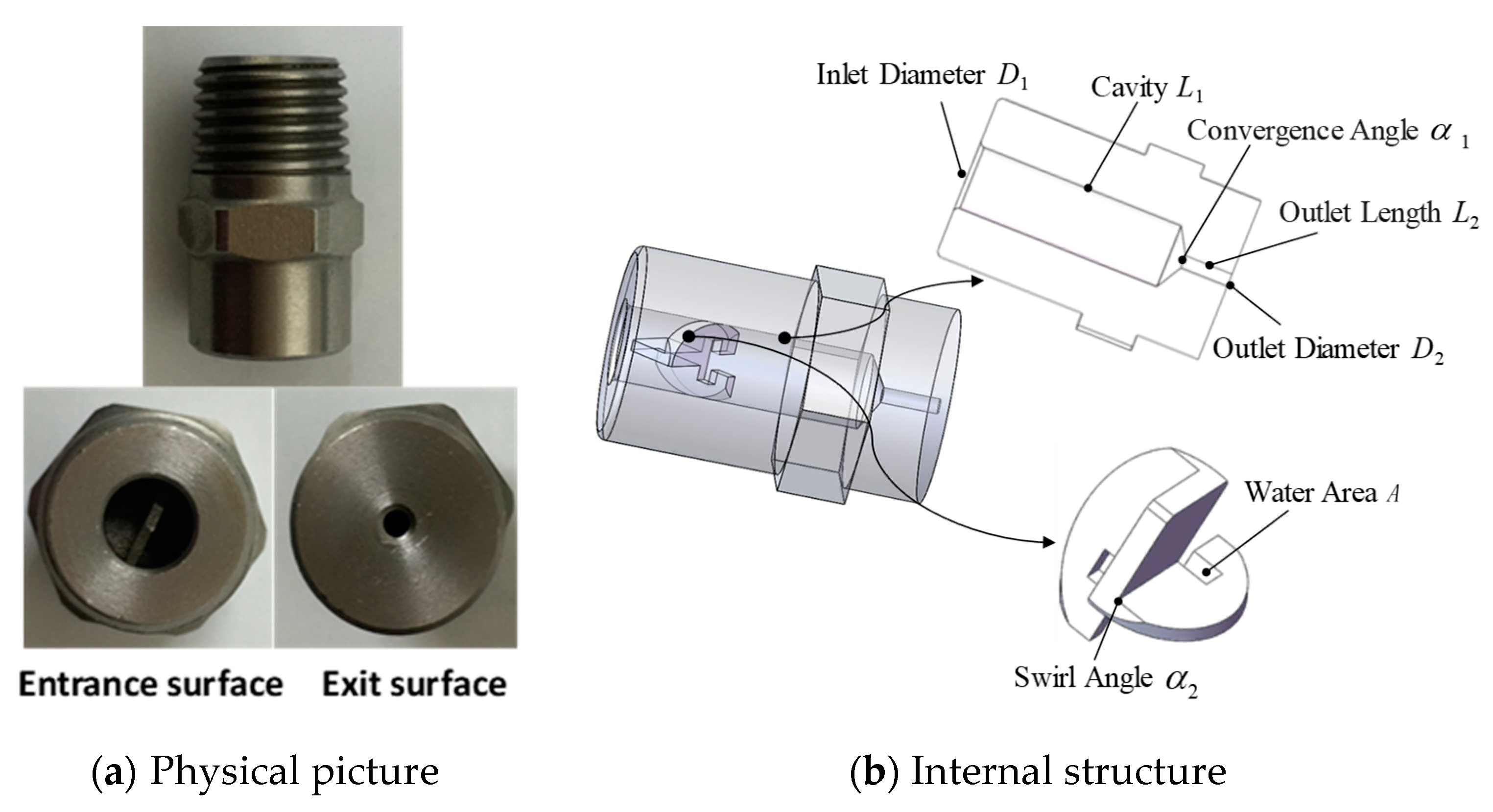
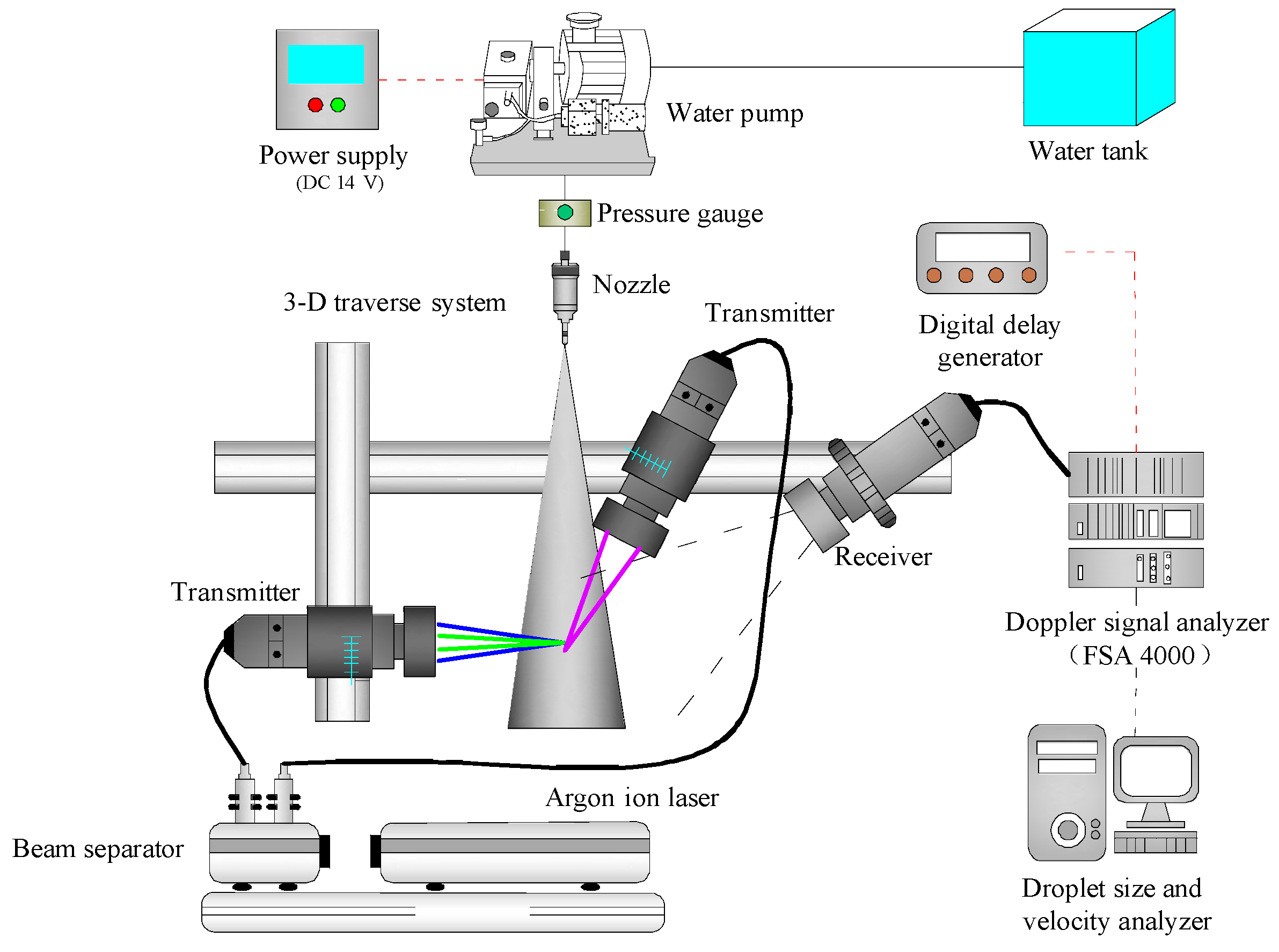



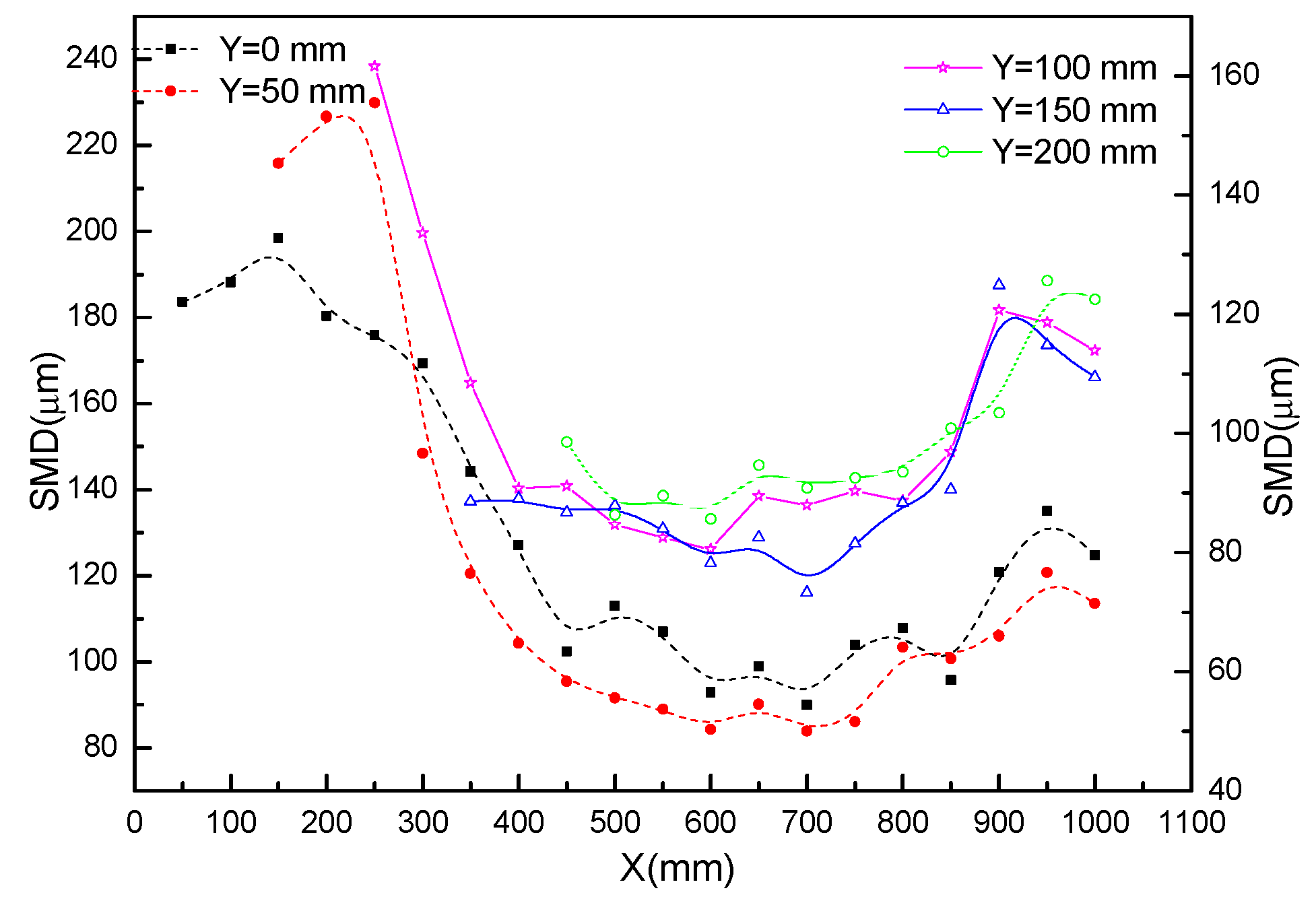
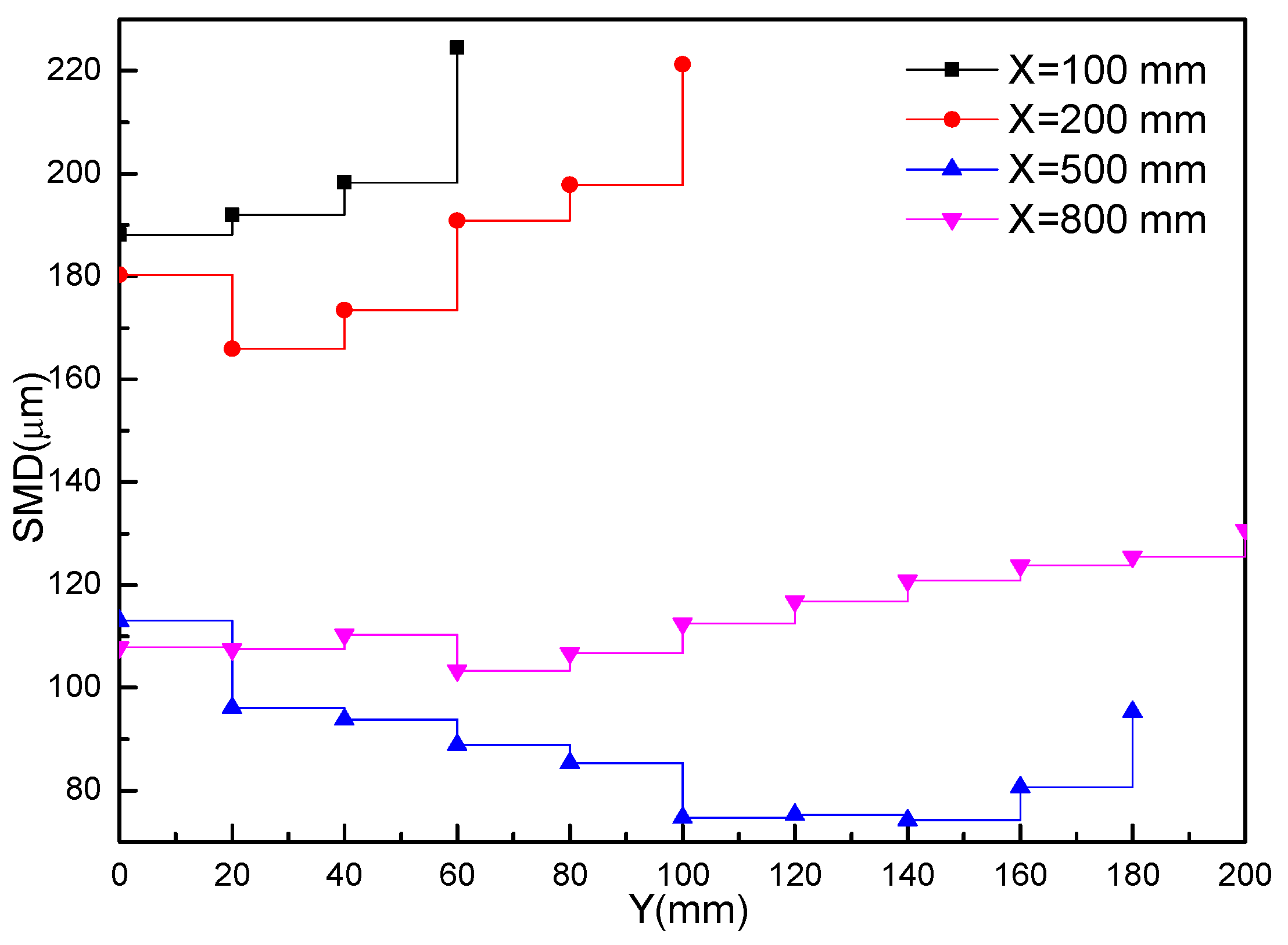
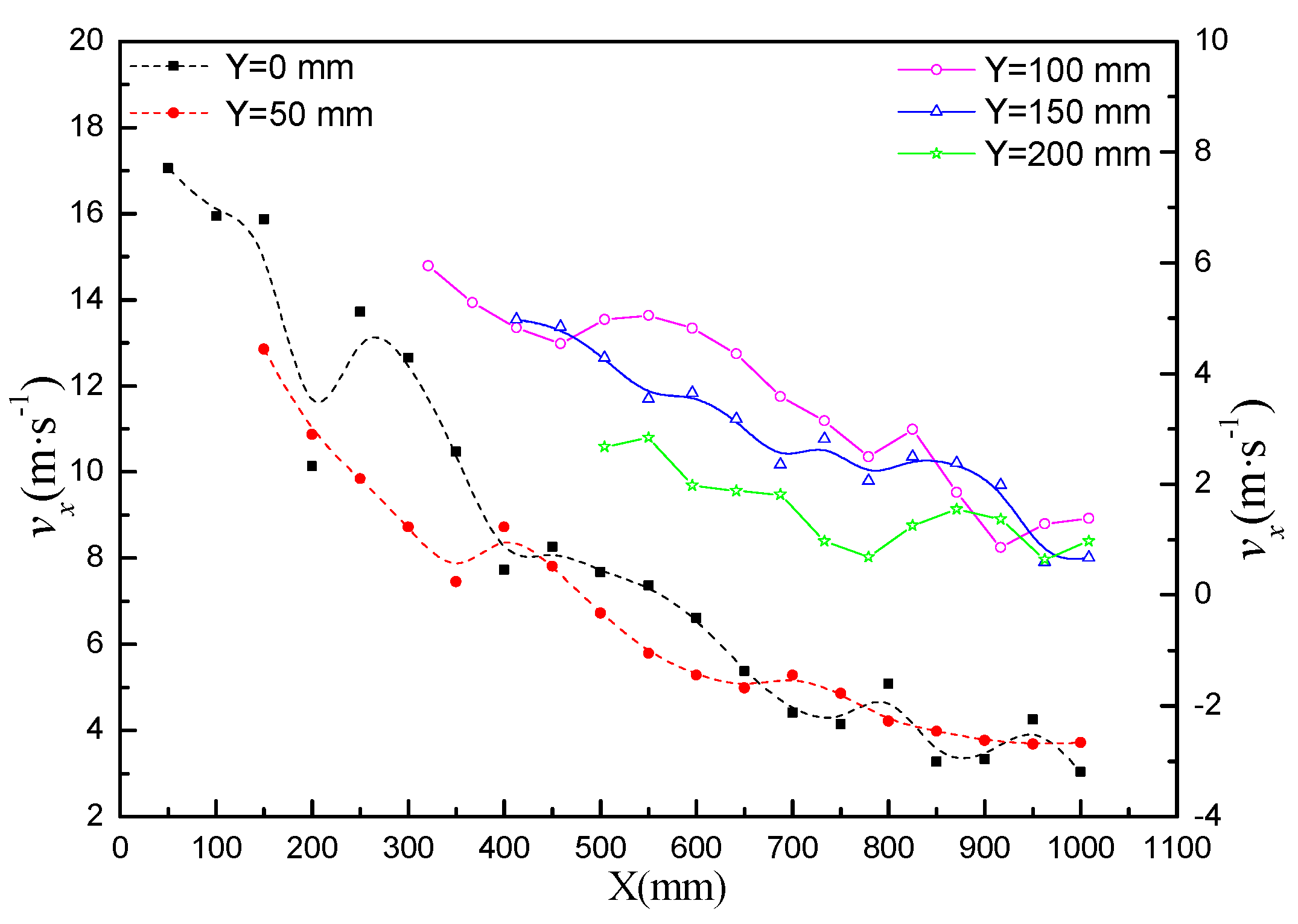
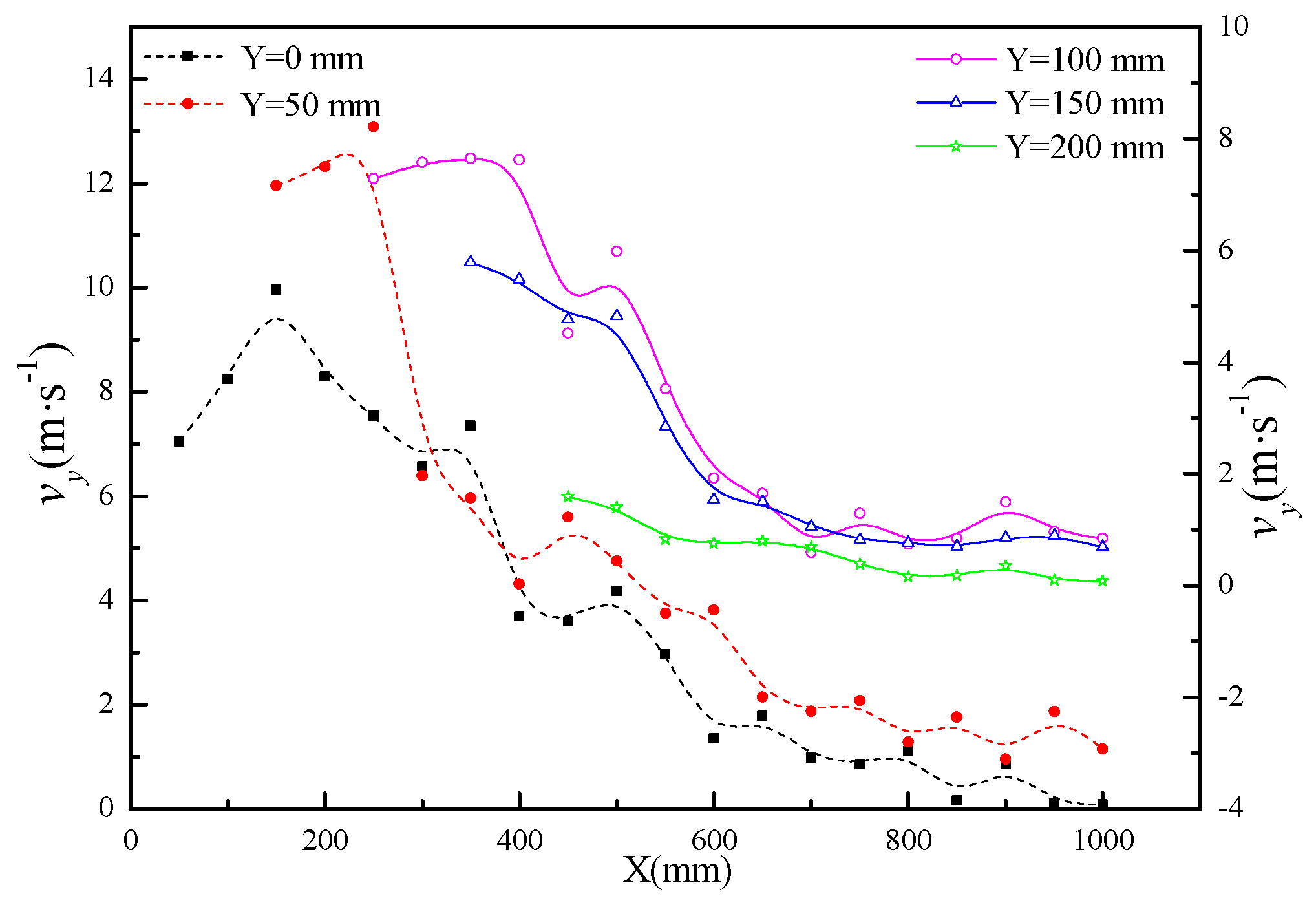
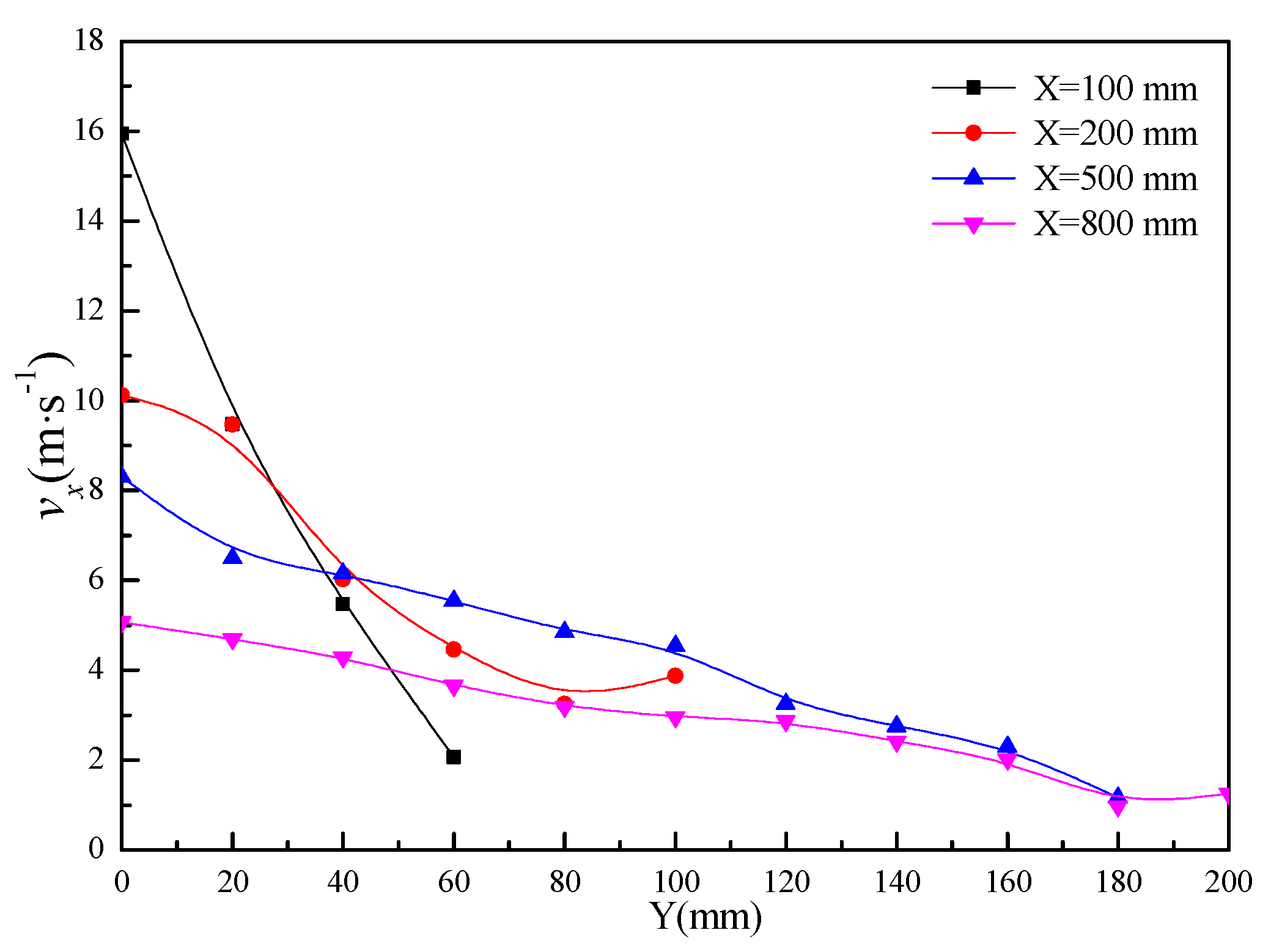
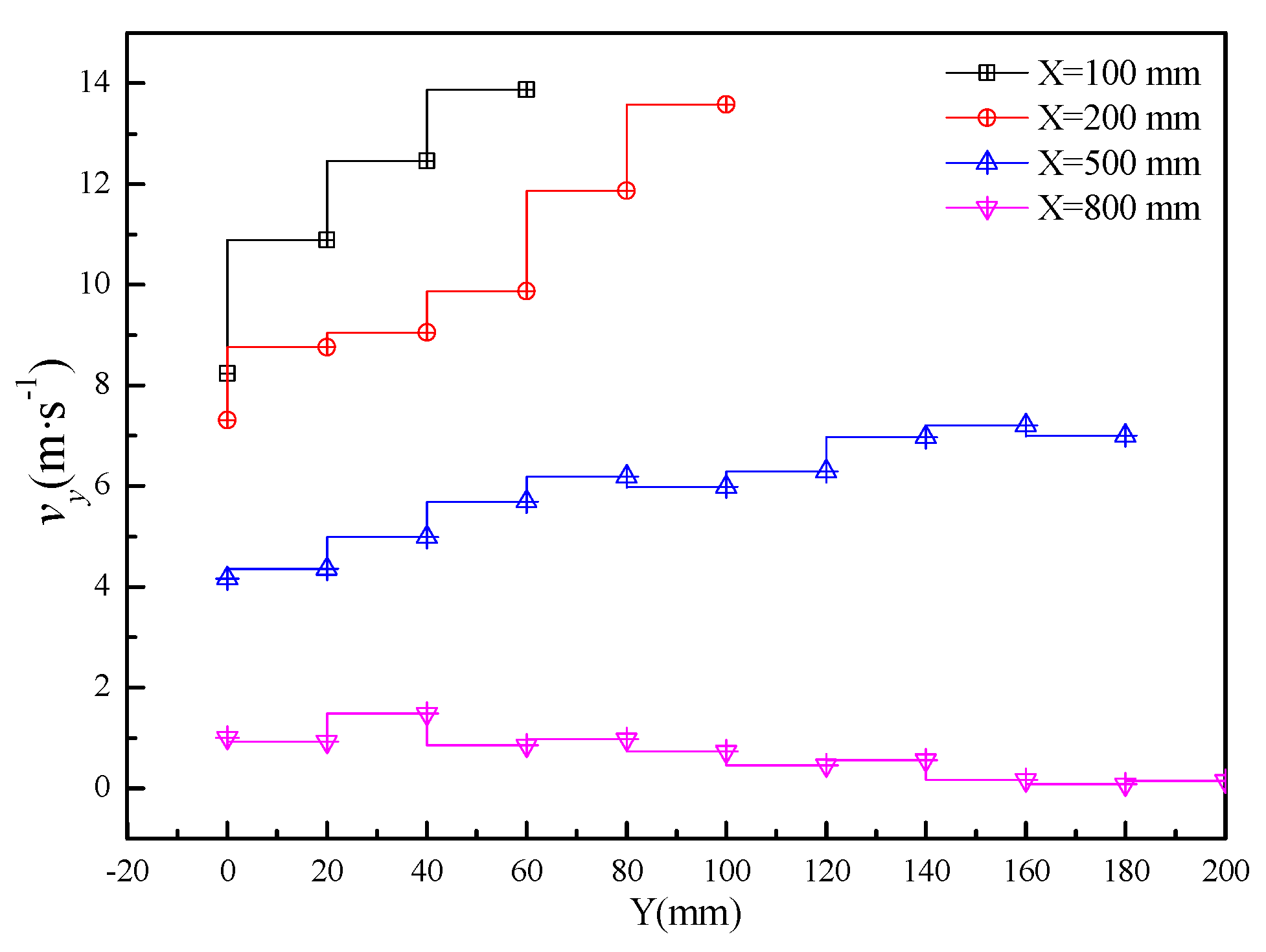
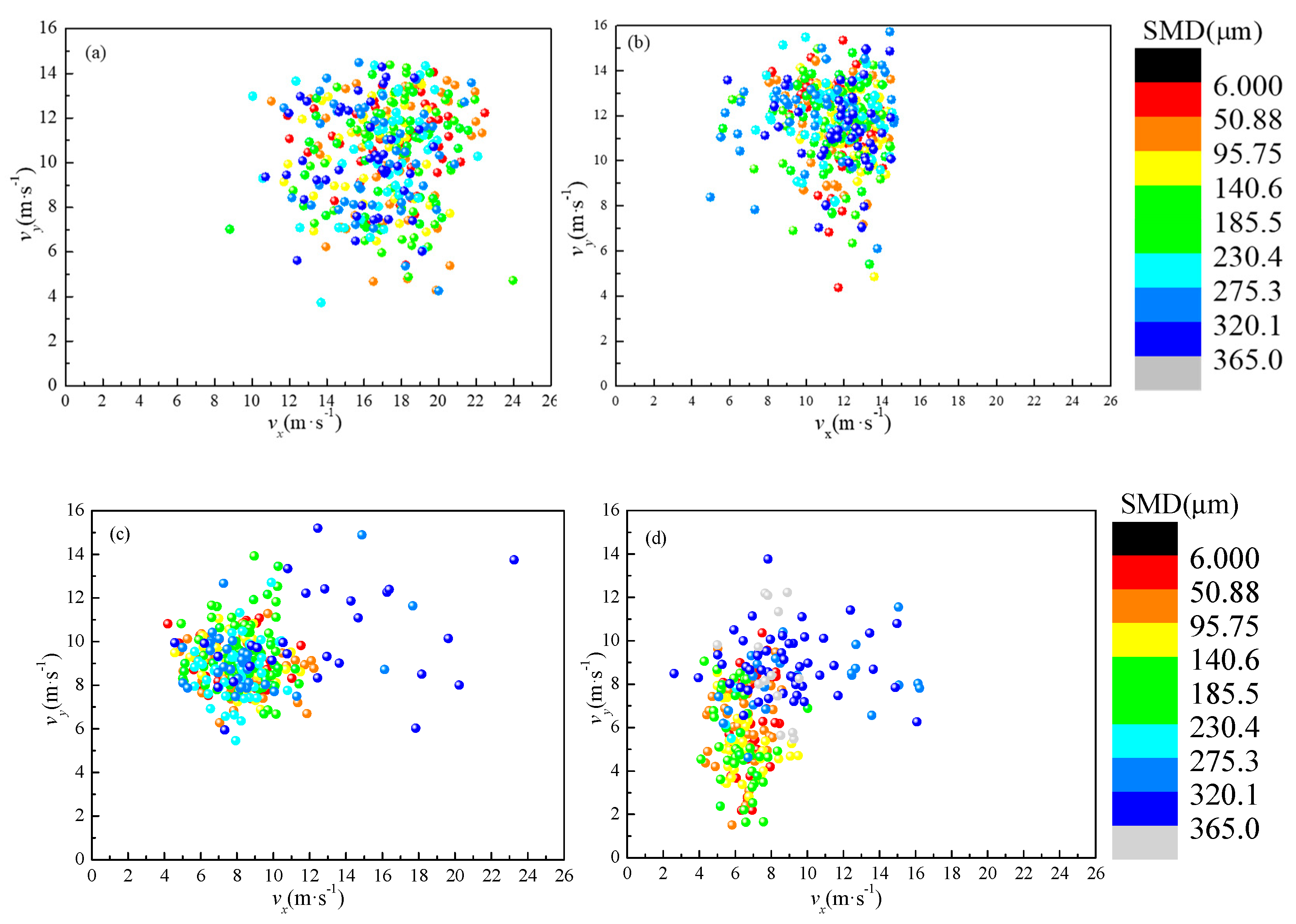
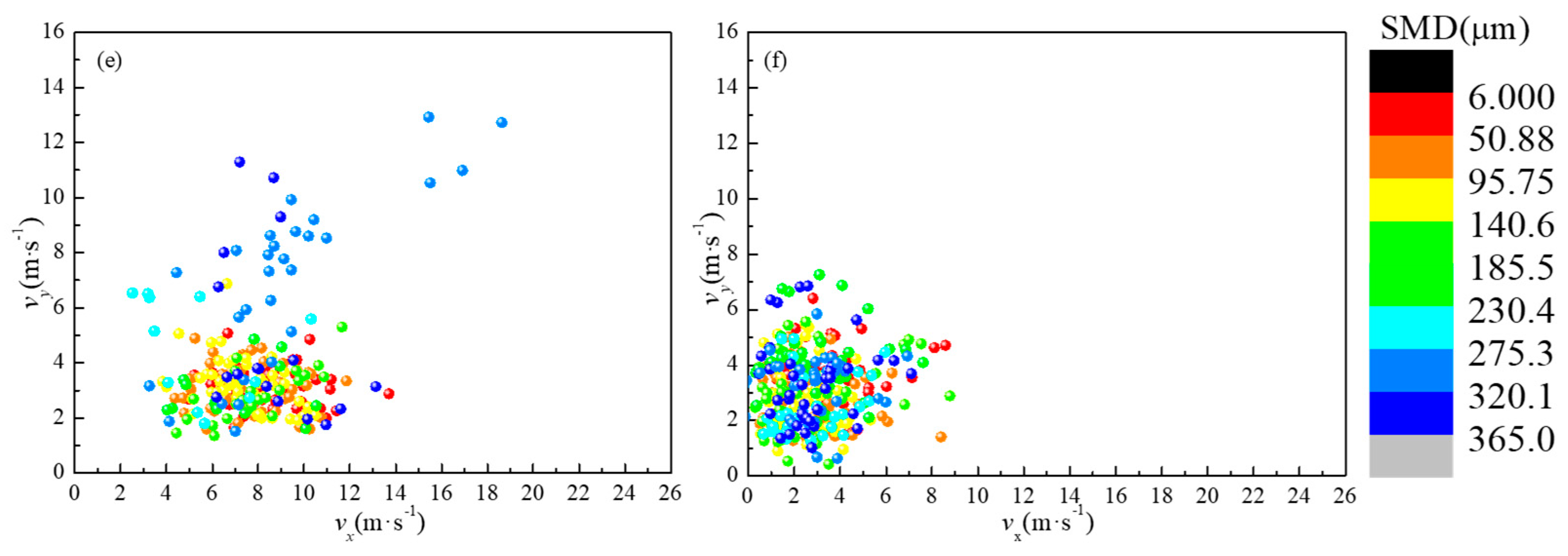



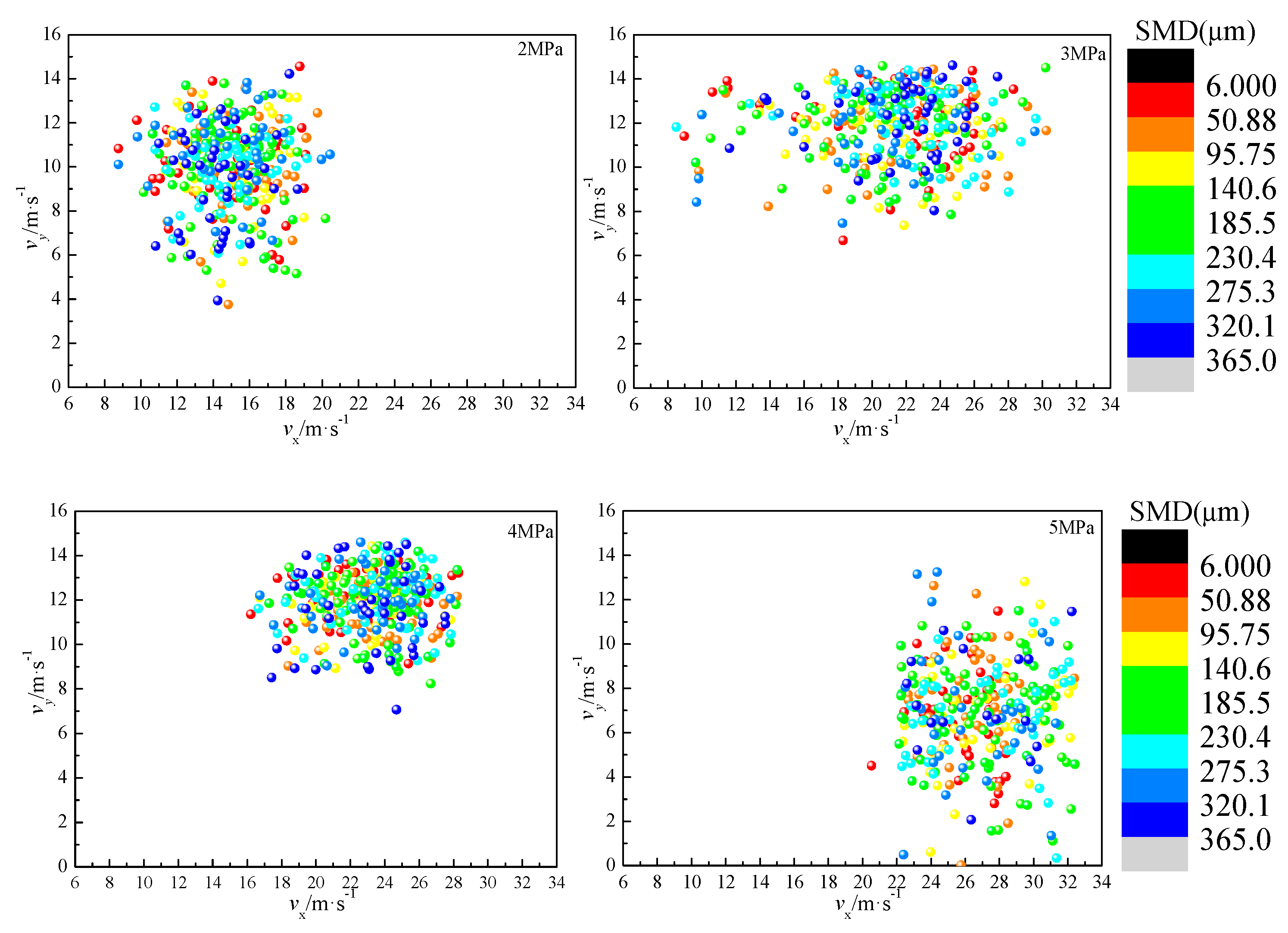
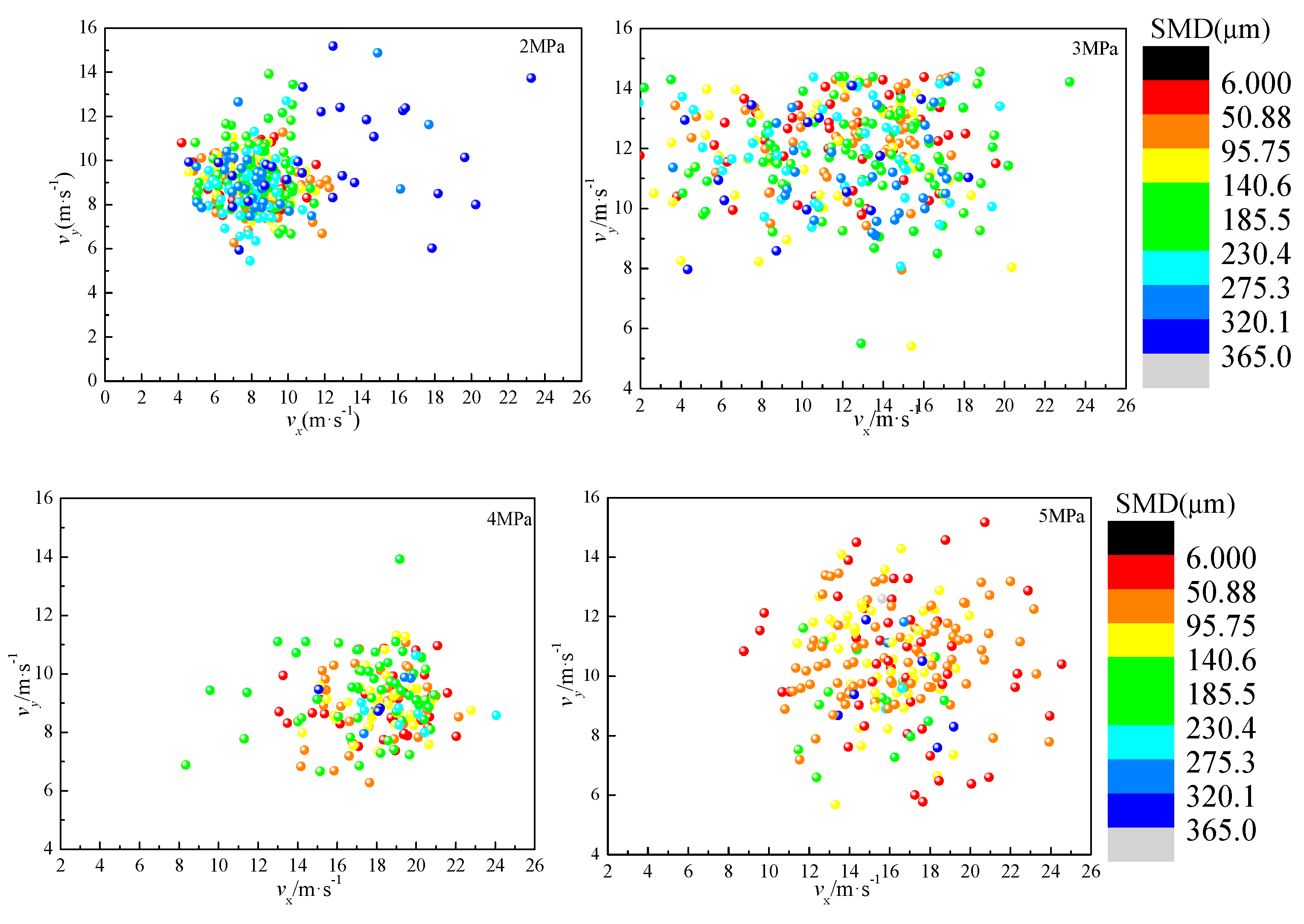
| A (mm2) | ||||||
|---|---|---|---|---|---|---|
| 5 | 15 | 100 | 1.5 | 6 | 1 | 35 |
| Parameters | Value |
|---|---|
| Bragg cell frequency | 40 MHz |
| Focal length of transmitting probe | 750 mm |
| Beam diameter | 1.77 mm |
| Beam spacing | 50 mm |
| Scattering angle | 40° |
| Velocity measurement range | −313 to 1600 m/s |
| Diameter measurement range | 0.5 to 5000 μm |
| Band pass filter | 1–10 MHz |
| Burst threshold | 30–300 mV |
© 2020 by the authors. Licensee MDPI, Basel, Switzerland. This article is an open access article distributed under the terms and conditions of the Creative Commons Attribution (CC BY) license (http://creativecommons.org/licenses/by/4.0/).
Share and Cite
Wang, J.; Xu, C.; Zhou, G.; Zhang, Y. Spray Structure and Characteristics of a Pressure-Swirl Dust Suppression Nozzle Using a Phase Doppler Particle Analyze. Processes 2020, 8, 1127. https://doi.org/10.3390/pr8091127
Wang J, Xu C, Zhou G, Zhang Y. Spray Structure and Characteristics of a Pressure-Swirl Dust Suppression Nozzle Using a Phase Doppler Particle Analyze. Processes. 2020; 8(9):1127. https://doi.org/10.3390/pr8091127
Chicago/Turabian StyleWang, Junpeng, Cuicui Xu, Gang Zhou, and Yansong Zhang. 2020. "Spray Structure and Characteristics of a Pressure-Swirl Dust Suppression Nozzle Using a Phase Doppler Particle Analyze" Processes 8, no. 9: 1127. https://doi.org/10.3390/pr8091127
APA StyleWang, J., Xu, C., Zhou, G., & Zhang, Y. (2020). Spray Structure and Characteristics of a Pressure-Swirl Dust Suppression Nozzle Using a Phase Doppler Particle Analyze. Processes, 8(9), 1127. https://doi.org/10.3390/pr8091127







